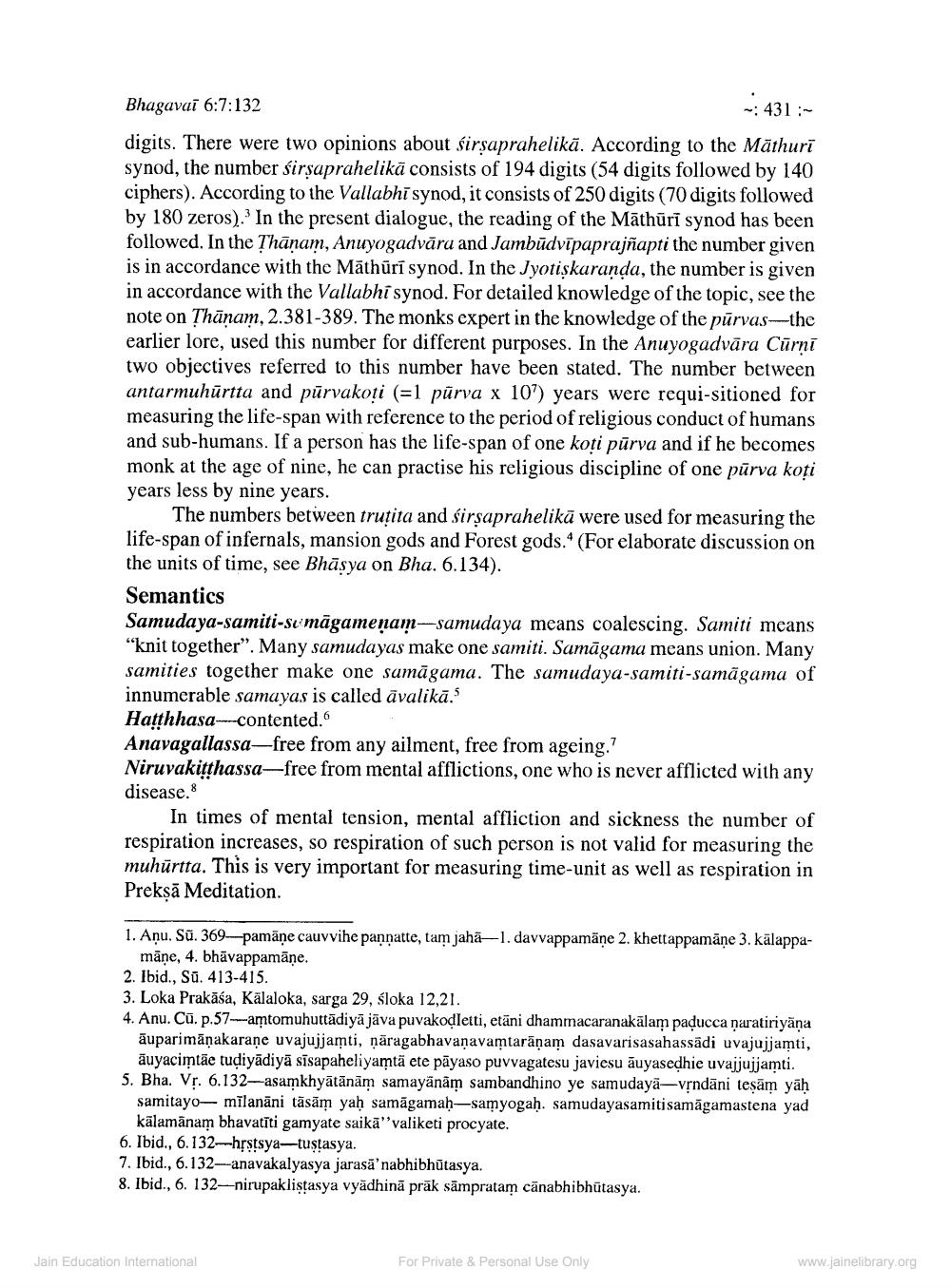________________
Bhagavai 6:7:132
-: 431 :digits. There were two opinions about sirsaprahelikā. According to the Māthuri synod, the number sirsaprahelikä consists of 194 digits (54 digits followed by 140 ciphers). According to the Vallabhi synod, it consists of 250 digits (70 digits followed by 180 zeros). In the present dialogue, the reading of the Māthūrī synod has been followed. In the Thānam, Anuyogadvāra and Jambūdvīpaprajñapti the number given is in accordance with the Mäthürī synod. In the Jyotiskaranda, the number is given in accordance with the Vallabhi synod. For detailed knowledge of the topic, see the note on Thānam, 2.381-389. The monks expert in the knowledge of the pūrvas-the earlier lore, used this number for different purposes. In the Anuyogadvāra Cūrņi two objectives referred to this number have been stated. The number between antarmuhurtta and pūrvakoti (=1 pūrva x 10) years were requi-sitioned for measuring the life-span with reference to the period of religious conduct of humans and sub-humans. If a person has the life-span of one koți pūrva and if he becomes monk at the age of nine, he can practise his religious discipline of one pūrva koți years less by nine years.
The numbers between trutita and sirsaprahelikā were used for measuring the life-span of infernals, mansion gods and Forest gods.(For elaborate discussion on the units of time, see Bhāsya on Bha. 6.134). Semantics Samudaya-samiti-su māgameņam-samudaya means coalescing. Samiti means “knit together". Many samudayas make one samiti. Samāgama means union. Many samities together make one samāgama. The samudaya-samiti-samāgama of innumerable samayas is called avalikā. Hatthhasa--contented. Anavagallassa-free from any ailment, free from ageing.' Niruvakitthassa-free from mental afflictions, one who is never afflicted with any disease. 8
In times of mental tension, mental affliction and sickness the number of respiration increases, so respiration of such person is not valid for measuring the muhurtta. This is very important for measuring time-unit as well as respiration in Preksā Meditation
1. Aņu. Sū. 369-pamāṇe cauvvihe pannatte, tam jahā— 1. davvappamāṇe 2. khettappamāne 3. kālappa
māne, 4. bhāvappamāne. 2. Ibid., Sū. 413-415. 3. Loka Prakāśa, Kalaloka, sarga 29, sloka 12,21. 4. Anu. Cū. p.57-amtomuhuttādiyā jāva puvakodletti, etāni dhammacaranakālam paducca naratiriyäņa
auparimāņakarane uvajujjamti, ņāragabhavanavamtarāņam dasavarisasahassādi uvajujjamti,
Zuyacimtāe tudiyādiyā sīsapaheliyamtä ete pāyaso puvvagatesu javiesu āuyasedhie uvajjujjamti. 5. Bha. Vp. 6.132-asamkhyātānām samayānām sambandhino ye samudayā—vrndāni teşām yāḥ
samitayo- mīlanāni tāsām yaḥ samāgamah-samyogah, samudayasamitisamāgamastena yad
kālamānam bhavatīti gamyate saikā'' valiketi procyate. 6. Ibid., 6.132-hrstsya-tustasya. 7. Ibid., 6.132-anavakalyasya jarasā' nabhibhūtasya. 8. Ibid., 6. 132—nirupaklistasya vyadhinā prāk sāmpratam cānabhibhūtasya.
Jain Education International
For Private & Personal Use Only
www.jainelibrary.org




